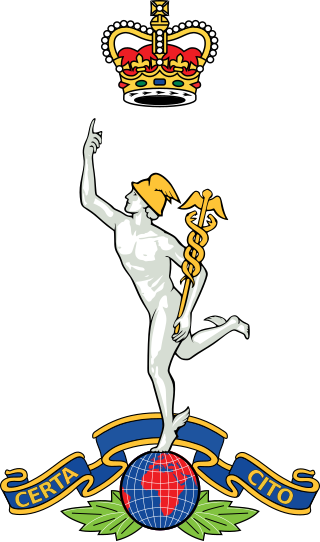
The Royal Regiment of Artillery, commonly referred to as the Royal Artillery (RA) and colloquially known as "The Gunners", is one of two regiments that make up the artillery arm of the British Army. The Royal Regiment of Artillery comprises thirteen Regular Army regiments, the King's Troop Royal Horse Artillery and five Army Reserve regiments.

Yeomanry is a designation used by a number of units and sub-units in the British Army Reserve which are descended from volunteer cavalry regiments that now serve in a variety of different roles.
Options for Change was a restructuring of the British Armed Forces in summer 1990 after the end of the Cold War.

44th Parachute Brigade was a British Army Territorial Army parachute brigade, active from c.1950 to 1978.

562 Parachute Squadron Royal Corps of Transport (Volunteers) was a minor unit that supported 44th Parachute Brigade (V).

The 107th Brigade, later 107th (Ulster) Brigade was an infantry formation of the British Army which saw service in the First World War. The brigade was later reformed during the Cold War and finally disbanded in 2006, following the drawdown of Operation Banner.

The Mechanized Brigade "Legnano" was a mechanized brigade of the Italian Army. Its core units were mechanized infantry battalions. The brigade's headquarters was in the city of Bergamo in Lombardy. The name of the brigade commemorates the Lombard League victory in the Battle of Legnano in 1176 and its coat of arms depicts the Monument to the Warrior of Legnano in the centre of Legnano.
71 Engineer Regiment is an Army Reserve regiment of the Royal Engineers, British Army. Its headquarters is at RAF Leuchars, Fife, and has units across Scotland, northern England and Northern Ireland. Its regular army paired unit is 39 Engineer Regiment, at Kinloss, Moray.

The structure of the British Army is being reorganised to the Future Soldier structure. The Army is commanded by the Chief of the General Staff (CGS), with Army Headquarters which is located in Andover, Hampshire. Subordinate to that post, there is a Commander Field Army, and a personnel and UK operations command, Home Command.
This is a list of units of the British Army's Royal Engineers.

525th (Antrim) Coast Regiment, Royal Artillery (TA) was a volunteer coastal defence unit of Britain's Territorial Army from 1937 until 1956. It was the first Territorial Army unit to be raised in Northern Ireland.
The Antrim Artillery was a part-time reserve unit of Britain's Royal Artillery based in County Antrim, Northern Ireland, from 1853 to 1919. It numbered 1st on the order of precedence of the Militia Artillery. Volunteers from the unit served in the Second Boer War. During World War I it defended Belfast Lough and trained gunners for service overseas. Subsequent units continued the Antrim Artillery traditions.
The 72nd Engineer Regiment was a territorial regiment of the Royal Engineers, British Army, for three periods between 1967 and 2014. The regiment was later reduced to squadron size and renamed as 103 Field Squadron within the 21st Engineer Regiment.
The 73rd Engineer Regiment was a Territorial regiment of the Royal Engineers, part of the British Army active from 1969 to 2014.

The Antrim Fortress Royal Engineers was a coast defence unit of the UK's Territorial Army formed in Northern Ireland in the late 1930s. During World War II it was converted to a parachute role and dropped into Normandy on D Day and across the Rhine during Operation Varsity. Its successors continue in the Army Reserve today.

Kimberley Barracks is a military installation on Deepdale Road in Preston in Lancashire, England PR1 6PR.

85 (Ulster) Signal Squadron was a military communications unit of the British Territorial Army, which formed part of the Royal Corps of Signals. The squadron was one of four signal squadrons which formed part of 40th (Ulster) Signal Regiment until its disbandment in 2009.










